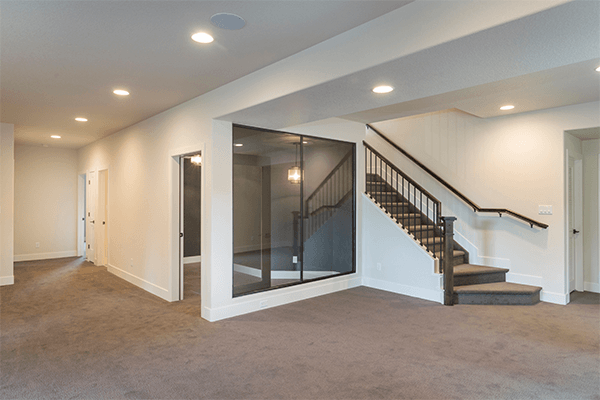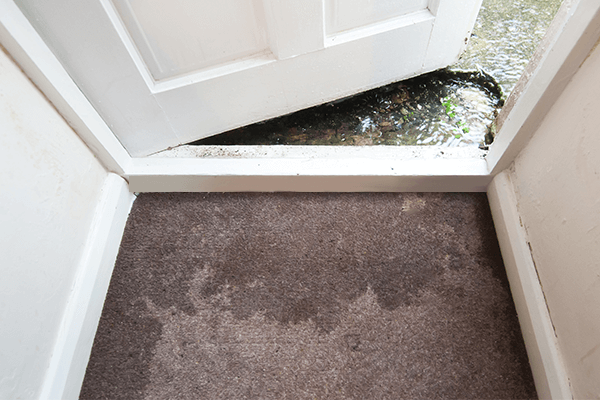How to Dry Wet Carpet
When severe storms that bring floods or heavy rain hit your town, it can mean bad news for your home, depending on your elevation and proximity to a river or dam. If harsh weather or other sources reach carpeting in your home, it’s important to act fast and speed up your dry time.

Categories of Water
There are three categories that describe the source and purity of the water that has soaked carpet or flooded your home. These categories affect how the water should be removed and the potential risks of drying the affected area.
See the tabs below for descriptions of each category of water.
-
Category 1 Water
Category 1 water originates from a sanitary water source and does not pose substantial risk from dermal contact, ingestion, or inhalation exposure.
Examples of Category 1 water sources can include but are not limited to:
- Broken water supply lines
- Tub or sink overflows with no contaminants
- Appliance malfunctions involving water supply lines
- Melting ice or snow
- Falling rainwater
- Broken toilet tanks and toilet bowls that do not contain contaminants or additives
That said, Category 1 water can deteriorate to Category 2 or 3 under certain circumstances. For example, Category 1 water that flows into an uncontaminated building doesn’t constitute an immediate change in the category, but if Category 1 water flows into a contaminated building, it can immediately experience a category change.
This is because once microorganisms become wet from the water intrusion, they begin to multiply. The multiplication rate depends on how long they’ve been wet and the temperature, which then also dictates how quickly the category change is likely to happen or how many category changes will happen.
Bacteria can multiply silently, but it can also cause tell-tale signs of water deteriorating, like odors. If you smell an odor, definitely be cautious and protect yourself from the health risks posed by that kind of water.
-
Category 2 Water
Category 2 water contains significant contamination and has the potential to cause discomfort or sickness if it comes into contact with humans, especially if it’s accidentally consumed. Category 2 water can also contain potentially unsafe levels of microorganisms or nutrients for microorganisms, as well as other organic or inorganic matter (chemical or biological).
Examples of Category 2 water can include but are not limited to:
- Discharge from dishwashers or washing machines
- Overflows from washing machines
- Overflows from toilet bowls on the room side of the trap with some urine but no feces
- Seepage due to hydrostatic pressure
- Broken aquariums
- Punctured water beds
Category 2 water can deteriorate to Category 3. Once microorganisms become wet from the water intrusion, they can begin to grow in numbers and change the category of the water, depending on the length of time they remain wet and the temperature.
Note: If your carpet is wet from category 2 water, you should call professionals immediately, as trying to clean it up yourself poses a risk to your health and your home.
-
Category 3 Water
Category 3 water is grossly contaminated and can contain pathogenic, toxigenic, or other harmful agents. It can cause significant adverse reactions in humans, especially if consumed, but simple skin contact can also cause a huge problem.
Examples of Category 3 water can include but are not limited to
- Sewage
- Waste line backflows that originate from beyond any trap regardless of visible content or color
- All forms of flooding from seawater
- Rising water from rivers or streams
- Other contaminated water entering or affecting the indoor environment, such as wind-driven rain from hurricanes, tropical storms, or other weather-related events
Category 3 water can carry trace levels of regulated or hazardous materials (e.g., pesticides or toxic organic substances).Porous and semi-porous building material that comes in contact with Category 3 water is likely to be discarded. The health concern associated with Category 3 water is based in part on regulations, human exposure, and the difficulty involved in cleaning up and disposing of regulated hazardous and unsanitary waste.
The longer the water sits in a structure, the greater the decline in the home’s conditions. Microbial growth can begin in as few as 48 hours, given the right conditions. OSHA states the general rule is if a porous material has been wet for over 48 hours, it’s best to remove and replace it.
This is why it’s important to dry carpet as quickly as possible. Since carpet is porous, wood subfloors and drywall can become wet and damaged beyond repair. Speed-drying the affected materials is the single most effective way to prevent or slow this growth.
- Porous materials: drywall, carpet, insulation, ceiling tile
- Semi-porous materials: wood, concrete
Note: If your carpet is wet from category 3 water, you should call professionals immediately, as attempting to clean it on your own will pose a greater risk to your health and your home.
Before You Dry
- Stop the source of water if possible. If you have a pipe leak, be sure to get this fixed ASAP.
- Dispose of any damaged items.
- Remove any furniture you can that could get damaged as well
- Limit traffic on carpet during this time. (More foot traffic means moisture is getting pushed down further into the carpet fiber.)
Note: If any electrical outlets or devices are wet or at risk of getting wet, turn off electricity in the room for safety purposes.

Drying Wet Carpet
- Remove Water
- Soak Up Water
- Create Air Flow in Room
- Check Subfloor
- Call the Experts
A common first step is using a wet-dry vacuum to remove as much water from the carpet as possible. Remember to empty the wet tank before use and remove any dry dust bags if possible. Most wet-dry vacuums will indicate when they’re full and need to be emptied again.
If the motor makes a high-pitched sound, unplug the vacuum and empty the wet tank. Running the vacuum with a full tank is bad for the motor and can cause damage, so it’s important to empty it regularly.
Repeat these steps as necessary while removing water from the carpet.
After vacuuming as much excess water as possible, it’s time to soak up the remaining water from the carpet. Spread towels, preferably microfiber, over your carpet and pat down to saturate the towels.
As the towels become oversaturated, replace them with fresh towels and repeat the process. Be sure to move any furniture during this process and blot the water in those areas, as well.
After removing and soaking up water, your next course of action is to create airflow in the room. You can do this by setting up fans throughout the room.
We like to use centrifugal and/or axial fans to create air movement. Centrifugal fans produce higher-pressure airflow, which makes them ideal for drying. That said, centrifugal fans also require more electrical power input, which is difficult if you have an older home. Axial fans are larger round fans where the airflow is focused on a direct target. These are used for general purposes and are not as powerful, but they’re still a good option if you can’t use centrifugal fans in your home.
Regardless of what fan you choose, be sure to use as many as possible and set them up evenly around the room. If you have a residential dehumidifier, also set it up near the carpet and check it regularly to see if it needs to be emptied to keep absorbing water from the floor.
If weather permits, you can also open windows and screen doors to let the natural airflow from outside help dry the carpet.
Next, check the subflooring to make sure the water is not deeply embedded underneath the carpet. Go to the corner of the room and pull back the carpet to assess the level of moisture that seeped through. If the carpet padding is wet, mold growth is possible, and the padding will need to be replaced.
If your carpet padding is, in fact, wet or you’re unable to dry your carpet successfully, it’s best to call the experts. We specialize in 24/7 water damage mitigation and restoration services and can work directly with your insurance company to process claims.
Our process extracts water you can see and water you can’t. We’re able to remove water from carpet, tile and grout, hardwood floors, natural stone, concrete, laminate floors, and vinyl floors. We will remove and replace any wet carpet padding, preventing continued water retention that causes foul odors. We also have the technology to detect water hidden in drywall and insulation.